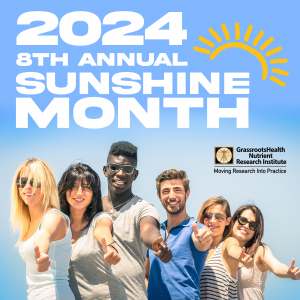Urgent Changes in Policy Regarding Sunshine Exposure and Health

Based on the latest research, experts now urge everyone to take an individualized approach to sun exposure advice based on skin type – learn more this May during the 8th annual Sunshine Month
Key Points
- New recommendations for sun exposure guidelines are now being tailored according to unique differences between three specific groups to correctly consider both the risks and benefits among each group, based on skin type, risk of skin cancer, and risk of vitamin D deficiency, officially recommending increased sun exposure for darker skinned people
- It is important to keep in mind that there are many benefits to sunshine exposure beyond vitamin D; exposure to UV radiation has many benefits independent of vitamin D, particularly for the immune system, with adequate vitamin D status being an indicator of having received sufficient sun exposure to obtain other benefits
- This Sunshine Month, please share this health-promoting information about safe, sensible sun exposure by following GrassrootsHealth, sharing the information and resources provided, and encouraging others to use the information to determine how they can best customize their sun exposure habits based on their skin type
Discover more about the health benefits of sensible, safe sun exposure with our free eBook here
 Encinitas, CA (May 1, 2024) Official recommendations for sunshine exposure have been evolving at a rapid pace over the last few years, although most of the general public has remained unaware of this new advice. Instead, the anti-sun slogan “Slip, Slop, Slap” has remained at the forefront of many people’s minds because of the association between excess sun exposure and an increased risk for skin cancer. While true for people with fair skin and a history of repeated sun burns, for the majority of the population, sensible sunshine exposure (in proper doses, without burning) can have a positive impact on health and may protect against disease, even helping people live longer. That is why GrassrootsHealth is excited to announce their 8th annual Sunshine Month this month of May, 2024.
Encinitas, CA (May 1, 2024) Official recommendations for sunshine exposure have been evolving at a rapid pace over the last few years, although most of the general public has remained unaware of this new advice. Instead, the anti-sun slogan “Slip, Slop, Slap” has remained at the forefront of many people’s minds because of the association between excess sun exposure and an increased risk for skin cancer. While true for people with fair skin and a history of repeated sun burns, for the majority of the population, sensible sunshine exposure (in proper doses, without burning) can have a positive impact on health and may protect against disease, even helping people live longer. That is why GrassrootsHealth is excited to announce their 8th annual Sunshine Month this month of May, 2024.
Australia is the First Country to Update Official Sun Exposure Guidelines Based on Skin Type
Last year (2023), Australia became the first country to provide updated guidelines for sun exposure based on skin type, officially recommending increased sun exposure for darker skinned people. The new recommendations are tailored according to unique differences between three specific groups to correctly consider both the risks and benefits among each group, based on skin type, risk of skin cancer, and risk of vitamin D deficiency. Those at high risk of skin cancer (individuals with very pale skin and/or olive/pale brown skin but with other risk factors) are advised to be more cautious with sunshine exposure and increase intake of vitamin D through diet and/or supplements. Those at low risk of skin cancer (individuals with constitutively dark skin) are advised to spend more time outdoors when the UV index is 3 or higher, with ample skin exposed. They suggest using sun protection only if spending extended amounts of time in the sun, after first exposing the skin without protection, making sure not to burn. Individuals in between these two groups, with an intermediate risk of skin cancer (such as those with olive or pale brown skin and no other risk factors), are advised be more cautious and to tailor their sun protection according to the UV index and time in the sun.
Since the release of these updated guidelines, two citizen juries were utilized in Australia to determine if it was time to update sun safety campaigns to recognize population diversity. They concluded,
“These citizens’ juries confirm that Australia needs updated sun safety campaigns that address both the harms and benefits of sun exposure. Updated campaigns should address relevant diversity—particularly diversity in skin tone and geographical location.” (Gregory et al., 2023)
In a newly published review titled “Sunlight: Time for a Rethink?”, Richard B. Weller states
“Dermatologists and skin researchers have made great progress in understanding some aspects of the interaction between UV and our skin, but we need to stand back and take a more holistic view of UV exposure and human health. The United Nations Environmental Effects Assessment panel (Neale et al, 2023) and an Australian panel endorsed by the Cancer Council of Australia and Australasian College of Dermatologists (Neale et al, 2024) have both just produced position statements recognizing that sunlight has beneficial effects that should be considered in formulating policy on sunlight exposure and highlighting the necessity of carrying out further research into these beneficial effects. We should take note.”
In the review, Weller also confirms that “Any advice on sun exposure must take skin color into account,” a key focus for Sunshine Month. These recommendations are endorsed by the Cancer Council Australia, Skin Cancer College Australasia, Australasian College of Dermatologists, Healthy Bones Australia, The Australian and New Zealand Bone and Mineral Society, Melanoma Patients Australia, and MS Australia.
The updates have prompted the UK National Institute for Health and Care Research to also review their sunlight guidelines for similar changes, according to a news article on the Australian Position titled “Why your skin needs to see the sun WITHOUT sunscreen every day: Experts have radically changed their rules for UV exposure and the risk of skin cancer – this is how it affects you.”
Interestingly, the idea of avoiding the sun has previously been called into question by major organizations in the UK, including Cancer Research UK, British Association of Dermatologists, Diabetes UK, the Multiple Sclerosis Society, the National Heart Forum, the National Osteoporosis Society and the Primary Care Dermatology Society. Back in 2010, these organizations came together to issue a joint position statement, saying
“…people are urged to enjoy the sun safely and take care not to burn, helping to ensure the benefits of vitamin D can be enjoyed without the risk of skin cancer being raised unnecessarily.”
Fourteen years have passed, and the fear-based messages promoting sun avoidance have yet to be replaced with messages about the many health benefits provided by safe, sensible sunshine exposure. GrassrootsHealth calls on everyone to build on the progress now being made starting with the new Australian position statement, and to increase the momentum of this message by participating in Sunshine Month this May.
Vitamin D Production in the Body is a Key Necessity from the Sun, and Measuring Vitamin D Status Can be an Indicator of Having Received Sufficient Sun Exposure
The body is designed to produce vitamin D in the skin upon exposure to UVB radiation from sunshine. The vitamin D level is therefore often used as a measurement for adequate sun exposure, and especially for those who don’t supplement with vitamin D, vitamin D deficiency can also indicate a “sunshine deficiency.” According to data from the 2013-2014 National Health and Nutrition Examination Survey (NHANES), approximately 23% of the United States population has vitamin D deficiency, with levels below 20 ng/ml (50 nmol/L), and a vast majority (89%) have levels below 40 ng/ml (100 nmol/L), the bottom level of the range recommended by the GrassrootsHealth panel of expert scientists.
It is important to keep in mind that there are many benefits to sunshine exposure beyond vitamin D. According to the Australian position statement
“Avoiding the sun and using dietary sources and/or vitamin D supplements to meet vitamin D requirements may seem an attractive solution. However, exposure to UV radiation may have benefits independently of vitamin D, particularly for the immune system, with adequate vitamin D status being an indicator of having received sufficient sun exposure to obtain other benefits. Further, exposing the eyes to longer wavelengths in sunlight reduces the risk of myopia, influences circadian rhythm, and improves sleep and mood. Aside from the direct benefits of sunlight, spending time outdoors facilitates physical activity, which plays a vital role in maintaining health and well-being. Thus completely avoiding sun exposure is not optimal for health.”
Help Spread the Message that Sunshine Exposure Can Provide Beneficial Effects Beyond What Can be Gained from Supplements Alone
This month, GrassrootsHealth will be sharing research on the many health benefits of sensible sun exposure, along with information on how to safely utilize sun exposure to balance the benefits with the risks that can result from excess exposure and sunburns. Topics will include
- how to determine skin type based on the Fitzpatrick Scale, and use your skin type to determine how much sun exposure may be needed
- how to safely make vitamin D from sunshine/UVB exposure without burning
- research showing how lifetime sun exposure can increase the lifespan
- additional benefits provided by full-spectrum sunlight exposure
- diseases associated with a lack of sunshine exposure, such as heart disease, insomnia, diabetes, many serious cancers, autoimmune diseases, mood disorders, dementia, and more
- how to balance the risk of sunburn with the benefits of sensible sun exposure
- and more…
A free eBook is provided by GrassrootsHealth during Sunshine Month, titled “Add Years to Your Health with Sunshine: How to Safely Use Sunshine for Longevity, Health & Joy.” This eBook is free to any person who signs up for the GrassrootsHealth newsletter, donates to the non-profit, or orders a vitamin D test kit as part of the Vitamin D*action study. Get the free eBook here.
Help Fight Sunshine Misinformation and Move Sunshine Research into Practice NOW!
This Sunshine Month, please share this health-promoting information about safe, sensible sun exposure by following GrassrootsHealth, sharing the information and resources provided, and encouraging others to use the information to determine how they can best customize their sun exposure habits based on their skin type.
SmartTan.com news articles regularly report medical and scientific information to keep you abreast of current events related to UV light. This information is not intended to be used by any party to make unwarranted health claims to promote sunbed usage. Indoor tanning businesses are obligated to communicate a fair and balanced message to all clients about your products and services including the potential risks associated with indoor tanning. Contact your Smart Tan representative to find out more about what you can and can’t say in your tanning salon business.
© 2024 International Smart Tan Network. All rights reserved.
